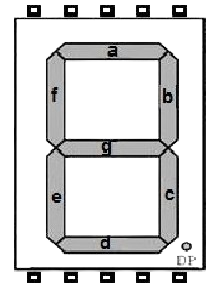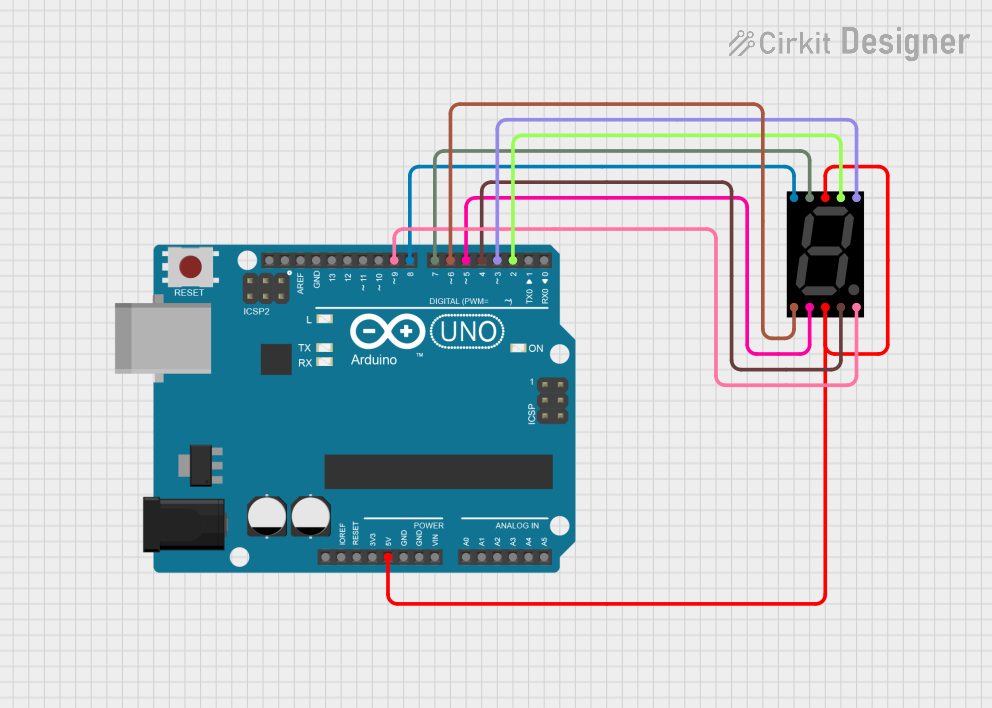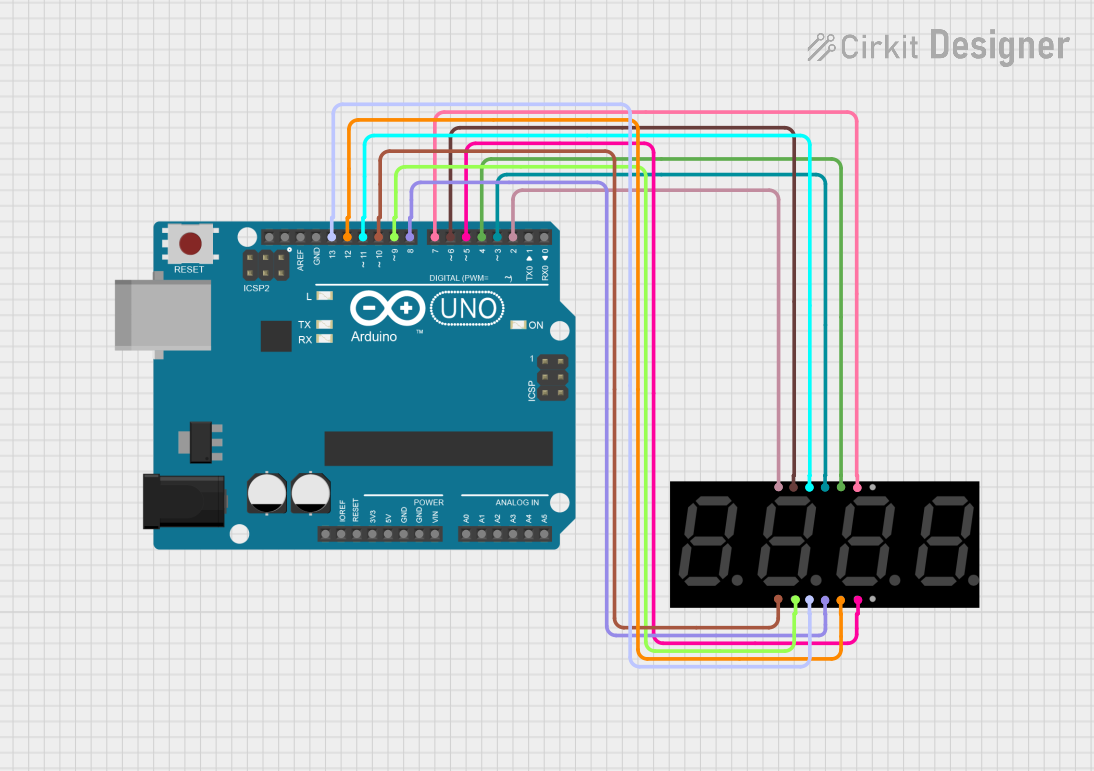
How to Use 7 segment: Examples, Pinouts, and Specs

 Design with 7 segment in Cirkit Designer
Design with 7 segment in Cirkit DesignerIntroduction
A 7-segment display is an electronic display device used to represent decimal numbers and some letters. Manufactured by IC, the IC 7 SEG is a versatile and widely used component in digital electronics. It consists of seven individual LED segments (labeled A through G) arranged in a rectangular pattern, with an optional decimal point. By illuminating specific segments, the display can represent digits from 0 to 9 and some alphabetic characters.
Explore Projects Built with 7 segment

 Open Project in Cirkit Designer
Open Project in Cirkit Designer
 Open Project in Cirkit Designer
Open Project in Cirkit Designer
 Open Project in Cirkit Designer
Open Project in Cirkit Designer
 Open Project in Cirkit Designer
Open Project in Cirkit DesignerExplore Projects Built with 7 segment

 Open Project in Cirkit Designer
Open Project in Cirkit Designer
 Open Project in Cirkit Designer
Open Project in Cirkit Designer
 Open Project in Cirkit Designer
Open Project in Cirkit Designer
 Open Project in Cirkit Designer
Open Project in Cirkit DesignerCommon Applications and Use Cases
- Digital clocks
- Electronic meters (e.g., voltmeters, ammeters)
- Calculators
- Scoreboards
- Embedded systems for numeric displays
Technical Specifications
Key Technical Details
- Manufacturer: IC
- Part ID: IC 7 SEG
- Operating Voltage: 2V to 3.3V (per segment, typical)
- Forward Current: 10mA to 20mA (per segment, typical)
- Power Dissipation: 70mW (maximum per segment)
- Display Type: Common Anode or Common Cathode (varies by model)
- Number of Segments: 7 (plus optional decimal point)
- Viewing Angle: 90° to 120°
- Operating Temperature: -40°C to +85°C
Pin Configuration and Descriptions
The IC 7 SEG display typically has 10 pins. The pin configuration depends on whether the display is a Common Anode or Common Cathode type. Below is a general pinout for a 7-segment display:
| Pin Number | Segment/Connection | Description |
|---|---|---|
| 1 | E | Controls segment E |
| 2 | D | Controls segment D |
| 3 | Common (Anode/Cathode) | Common connection for all segments |
| 4 | C | Controls segment C |
| 5 | Decimal Point (DP) | Controls the decimal point |
| 6 | B | Controls segment B |
| 7 | A | Controls segment A |
| 8 | Common (Anode/Cathode) | Common connection for all segments |
| 9 | F | Controls segment F |
| 10 | G | Controls segment G |
Note: Verify the datasheet for your specific IC 7 SEG model to confirm the pinout.
Usage Instructions
How to Use the Component in a Circuit
Determine the Type: Identify whether your 7-segment display is a Common Anode or Common Cathode type.
- In a Common Anode display, all anodes are connected together, and segments are activated by grounding their cathodes.
- In a Common Cathode display, all cathodes are connected together, and segments are activated by applying voltage to their anodes.
Connect the Pins:
- Connect the common pin (anode or cathode) to the appropriate power rail (VCC or GND).
- Use current-limiting resistors (typically 220Ω to 1kΩ) in series with each segment to prevent excessive current flow.
Control the Segments:
- Use a microcontroller (e.g., Arduino UNO) or a driver IC (e.g., 74HC595) to control the individual segments.
- Activate the segments by applying the appropriate voltage or ground signal.
Example: Connecting to an Arduino UNO
Below is an example of how to connect and control a Common Cathode 7-segment display using an Arduino UNO:
Circuit Connections
- Connect the common cathode pin to GND.
- Connect each segment pin (A, B, C, D, E, F, G, DP) to Arduino digital pins through 220Ω resistors.
Arduino Code
// Define the Arduino pins connected to the 7-segment display segments
const int segmentPins[] = {2, 3, 4, 5, 6, 7, 8, 9}; // A, B, C, D, E, F, G, DP
// Define the segment patterns for digits 0-9
const byte digitPatterns[] = {
0b00111111, // 0
0b00000110, // 1
0b01011011, // 2
0b01001111, // 3
0b01100110, // 4
0b01101101, // 5
0b01111101, // 6
0b00000111, // 7
0b01111111, // 8
0b01101111 // 9
};
void setup() {
// Set all segment pins as outputs
for (int i = 0; i < 8; i++) {
pinMode(segmentPins[i], OUTPUT);
}
}
void loop() {
// Display digits 0-9 in a loop
for (int digit = 0; digit < 10; digit++) {
displayDigit(digit);
delay(1000); // Wait 1 second before displaying the next digit
}
}
// Function to display a digit on the 7-segment display
void displayDigit(int digit) {
byte pattern = digitPatterns[digit];
for (int i = 0; i < 8; i++) {
// Write HIGH or LOW to each segment pin based on the pattern
digitalWrite(segmentPins[i], (pattern & (1 << i)) ? HIGH : LOW);
}
}
Important Considerations and Best Practices
- Always use current-limiting resistors to protect the LEDs in the display.
- Verify the type (Common Anode or Common Cathode) before wiring the display.
- Avoid exceeding the maximum forward current and power dissipation ratings.
- For multiplexed displays, consider using a driver IC to simplify control and reduce the number of required microcontroller pins.
Troubleshooting and FAQs
Common Issues and Solutions
Some Segments Do Not Light Up
- Cause: Loose connections or damaged segments.
- Solution: Check the wiring and ensure all connections are secure. Test the display with a multimeter or a simple circuit to verify functionality.
All Segments Light Up Dimly
- Cause: Insufficient current or incorrect resistor values.
- Solution: Use appropriate current-limiting resistors (e.g., 220Ω). Ensure the power supply can provide sufficient current.
Display Does Not Work at All
- Cause: Incorrect wiring or wrong common type (anode/cathode).
- Solution: Double-check the wiring and verify the display type. Ensure the common pin is connected to the correct power rail.
Segments Flicker or Behave Erratically
- Cause: Poor connections or insufficient power supply.
- Solution: Check for loose wires and ensure the power supply is stable and adequate.
FAQs
Q: Can I control a 7-segment display without a microcontroller?
A: Yes, you can use switches, a BCD-to-7-segment decoder IC (e.g., 7447), or other logic circuits.Q: How do I display letters on a 7-segment display?
A: Letters like A, b, C, d, E, and F can be displayed by illuminating specific segments. Refer to segment patterns for each letter.Q: Can I use a 7-segment display with a 3.3V microcontroller?
A: Yes, as long as the forward voltage of the segments is compatible and current-limiting resistors are used.
This concludes the documentation for the IC 7 SEG 7-segment display.